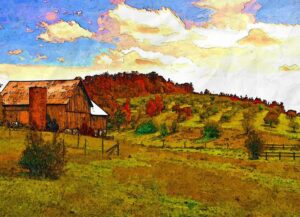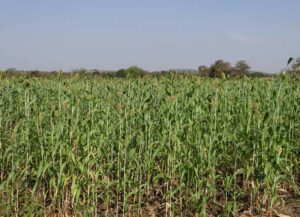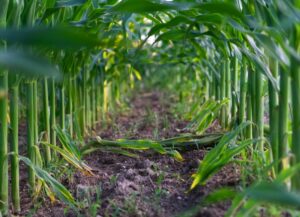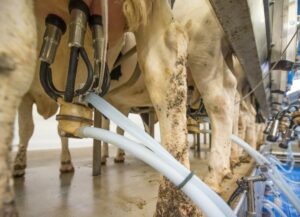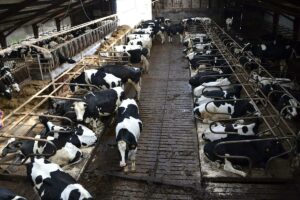Fernando Díaz
There are a wide variety of forage crops used in the United States for dairy farms. One of the most common is oat, as it provides the benefit of diversifying crop rotation. In fact, over 1.3 million hectares of oat were planted in the United States with over 60 percent of the output used for forage. Similar planted areas have been reported in Brazil, China, and other countries around the world. This diversification and inclusion of oat as a forage crop has a wide range of benefits for dairy farmers and agriculture as a whole.
Adding oat to a corn/soybean rotation, has been found to reduce pests and weeds in the farm and decrease diseases. It additionally can aid with sustainability efforts as these reductions in pests and weeds also decrease the need for chemical pesticides and herbicides. Oat has a wide range of uses, from human consumption to incorporation into animal rations through grain, hay, or silage.
There is a known interplay between forage dry matter harvested (quantity) and its nutritive value (quality). For dairy farms, the traditional recommendation has been to harvest oat at the boot stage. This is believed to maximize nutritive value and prioritize nutrition above yield. Agronomists from the University of Wisconsin, Madison (Favre et al., 2019) determined the optimal maturity stage for harvesting oat forage to maximize milk production. The researchers presented “milk production per hectare” as an alternative metric for dairy farmers using oat as the main forage in the diet.
The researchers evaluated two forage-type oat cultivars (ForagePlus and Laker) during 2016 and 2017 at the Arlington and West Madison Agricultural Research Stations in Wisconsin. Both hybrids are very high-yielding crops (+7800 kg/ha) and have similar nutritive value. Research fields were planted with conventional tillage and seeded in rows 0.15 meters apart at a density of 90 kg/ha. The fields had grown soy in the previous cycle so fertilizer was not applied. Harvest was conducted at 4 times: boot stage, 2 days post-boot stage, heading, and 5 days post-heading. The boot stage was defined as when 50 percent of the reproductive stems in the plot reached the R0 stage of growth, and heading was reached when 50 percent of the reproductive stems reached the R3 stage.
Once each plot reached the desired stage of growth, the forage was harvested, dried, and weighed. Samples from each time and plot were then analyzed for nutritional value. The authors calculated milk production per ton of forage using the MILK2016 equation, and milk production per hectare by multiplying forage yield per hectare (in tons) and milk per ton of forage.
| Cultivar | Maturity | ADF | NDF | NDFD48 | CP | RFQ |
| Stage | % DM | % NDF | % DM | |||
| ForagePlus | Boot Stage | 37.2 | 56.1 | 63.8 | 12.3 | 138 |
| Boot Stage + 2d | 37.7 | 56.5 | 63.2 | 12.0 | 134 | |
| Heading | 38.4 | 60.5 | 55.0 | 10.8 | 121 | |
| Heading + 2d | 40.3 | 60.5 | 55.0 | 10.0 | 103 | |
| Laker | Boot Stage | 35.7 | 54.1 | 63.5 | 12.8 | 141 |
| Boot Stage + 2d | 37.5 | 56.5 | 58.5 | 12.2 | 128 | |
| Heading | 40.9 | 60.5 | 57.6 | 10.5 | 102 | |
| Heading + 2d | 41.3 | 61.0 | 52.0 | 9.8 | 94 | |
The results, published in Crop, Forage & Turfgrass Management magazine, showed the following differences in harvesting times and cultivars:
- As expected, forage yield increased from boot state to late heading in both locations: 9870 and 7513 kg/ha in Arlington and Madison, respectively. This difference in yield was probably due to greater precipitation in the first location.
- The calculated milk production per hectare was maximal at the latest harvest time point, heading plus 5 days, in Arlington with an average for both hybrids of 10,170 kg of milk per hectare. In Madison, Laker also produced more milk per hectare at the latest harvest (7988 kg); however, ForagePlus production remained stable across harvesting times (7557 kg milk/ha). These results indicate that forage tonnage is the main driver for milk yield per area.
- As expected, forage nutritive value decreased linearly with increasing maturity at harvest (table). While fiber (acid and neutral detergent fiber) content increased from the boot stage to late heading, fiber digestibility and protein content decreased. Therefore, the relative forage (RFQ) quality of the oat forage was reduced on average by more than 40 units.
- Laker cultivar reached the boot stage consistently earlier (4 days or 77 growing degree-days) than ForagePlus. This allows the next crop to be planted sooner.
The researchers concluded that forage dry matter yield is the main factor that predicts milk production per hectare. Consequently, harvesting oat at the late heading stage maximizes milk production, provided that soil moisture is adequate. There are, however, limitations to this particular study. This model assumed that oat forage is the only feed in the diet. Moreover, it does not take into account that low-quality oat forage may limit cow intake, reducing milk production. Therefore, to maximize milk yield in high-producing cows, oat forage should be harvested at boot stage or sooner.
References
Jeremie R. Favre, Kenneth A. Albrecht, Lucia Gutierrez, and Valentin D. Picasso. 2019. Harvesting oat forage at late heading increases milk production per unit of area. Crop, Forage & Turfgrass Management.
© 2019 Dairy Knowledge Center. All Rights Reserved.



